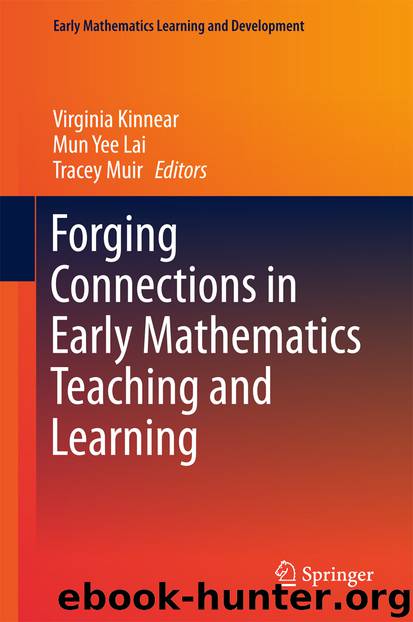Forging Connections in Early Mathematics Teaching and Learning by Virginia Kinnear Mun Yee Lai & Tracey Muir

Author:Virginia Kinnear, Mun Yee Lai & Tracey Muir
Language: eng
Format: epub
Publisher: Springer Singapore, Singapore
At this point, the children can be guided via further activities to gradually progress towards vertical mathematization:“Putting 6 Hello Kitties and 2 Hello Kitties together in a group and count to get 8 Hello Kitties”
“6 and 2 put together is 8”
“6 and 2 more is 8”
“6 + 2 = 8”
When children are engaged in vertical mathematization, mathematical objects (in this case number symbols) take over and daily life objects (like the Hello Kitties) lose their dominance. In the process of conceptualizing the mathematical knowledge, “6 and 2 is 8” and “6 + 2 = 8” become objects that children can use to connect to and acquire further mathematical knowledge. The purpose of guided reinvention then is to reify prior mathematical experiences and to make connection between different levels of learning experiences lead to vertical mathematization. Making sense of a mathematical experience is an important motivation for children to learn. Children’s choices of how to order the spatial positions of the two groups of Hello Kitties can be used to open up an awareness of the commutative property of number addition. That is, counting the group of two Hello Kitties first follows by counting the group of six Hello Kitties or vice versa gives the same result: eight Hello Kitties. This sense making can be further developed through a mathematizing process to reach the equivalent relationship “6 + 2 = 2 + 6”. With a sensible reification, that is, construction of mathematical objects that make sense to the children, mathematization processes can connect with each other, enabling children to construct personally significant mathematical conceptual knowledge and skills.
Guided reinvention in this sense serves as an overarching pedagogical design heuristic that enables children to take initiatives to generate their own knowledge under deliberately designed experiences in the learning environment. In the process of guided reinvention, teachers design learning experiences for children that require symbolizing, that is, children need to find for themselves progressive layers of mathematical symbols that will enable connections to be made from personal to formal symbols. Daily life objects that are real to the children (e.g. Hello Kitties) are linked to known symbols (e.g. numerals). The act of putting things together leads to the need to make symbols for addition.
Download
This site does not store any files on its server. We only index and link to content provided by other sites. Please contact the content providers to delete copyright contents if any and email us, we'll remove relevant links or contents immediately.
The Art of Coaching Workbook by Elena Aguilar(50731)
Trainspotting by Irvine Welsh(21407)
Twilight of the Idols With the Antichrist and Ecce Homo by Friedrich Nietzsche(18441)
Fangirl by Rainbow Rowell(9005)
Periodization Training for Sports by Tudor Bompa(8090)
Change Your Questions, Change Your Life by Marilee Adams(7551)
This Is How You Lose Her by Junot Diaz(6694)
Asking the Right Questions: A Guide to Critical Thinking by M. Neil Browne & Stuart M. Keeley(5569)
Grit by Angela Duckworth(5442)
Red Sparrow by Jason Matthews(5317)
Paper Towns by Green John(5018)
Room 212 by Kate Stewart(4954)
Ken Follett - World without end by Ken Follett(4587)
Housekeeping by Marilynne Robinson(4243)
The Sports Rules Book by Human Kinetics(4205)
Papillon (English) by Henri Charrière(4138)
Double Down (Diary of a Wimpy Kid Book 11) by Jeff Kinney(4124)
The Motorcycle Diaries by Ernesto Che Guevara(3925)
Exercise Technique Manual for Resistance Training by National Strength & Conditioning Association(3900)
